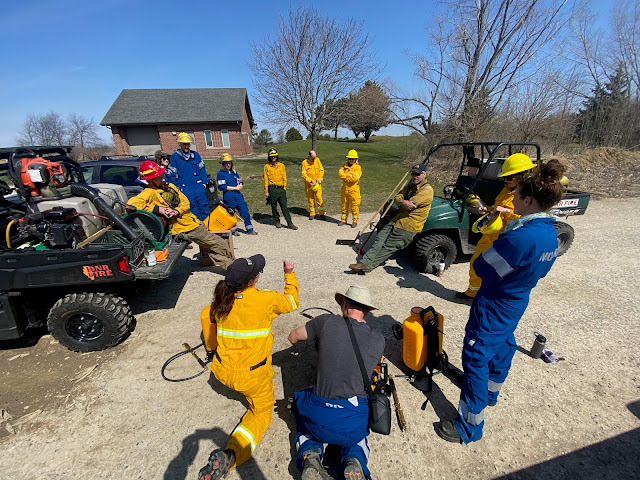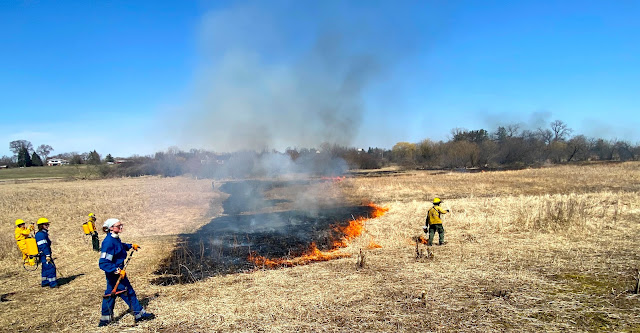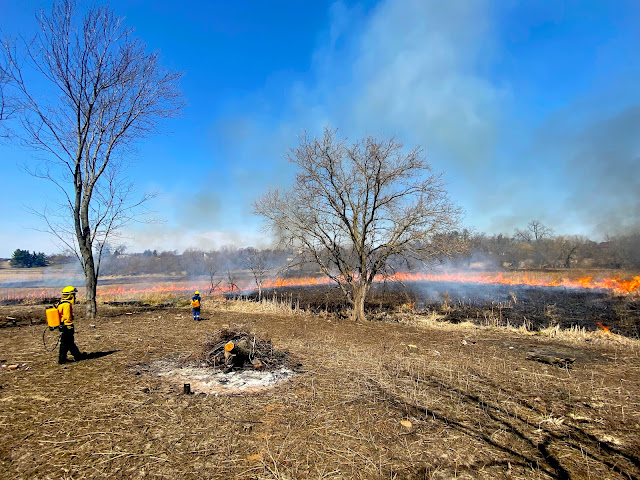Burning Kishwaukee Fen Nature Preserve in Lakewood, McHenry County.
The burn itself, like most burns, was inspiring, especially at its height. But a lot more interesting is the process that makes the burn safe and effective.
First we gather and review the plan:
That plan was prepared this time by Illinois Nature Preserves staff John Nelson. As shown on John's map, with a wind from the southwest, our first job would be to start at A and carefully complete a backfire to B.
We study the map and divide responsibilities.
We study the map and ask questions.Our target, before we start, is shown above. A-B is in the foreground: a degraded, early-stage prairie restoration with not much fuel. In the background are the fens and sedge meadows, with lots of fuel.
And now, we've reached point D on the plan. For a refresher, see below.
Once we've finished break C - D (through heavy fuel) and burned the little there was to burn through a bit of brush and to the golf course, we're done with most of our work.At this point, the headfire is lit.
In the drone video below by David Martin, we can see fire behavior after the breaks are complete and the headfire has been lit. In this video, it's impressive how the short flames of the slow-moving backfire compare to headfire flames, which reach many times higher, burn hotter, and move faster.
At this point we noticed that one of the raised fens had entirely escaped the burn. The sedge meadow that surrounded it was wet and had little fuel, as last year we had sprayed out the invasive Reed Canary Grass that had been thick there. But it was the fens that were the priority to enrich by burning, so Ben Davies hiked back down with the drip torch and touched it off.
At the end, we gathered for an "after action review." Was the burn as hot as we hoped? A fall burn might have been preferred. In spring wetlands tend to have a lot of standing water (with snow-melt and all), so this burn may have been less effective in deterring some weeds and top-killing some brush. Fall burns once roared across the landscape for miles. The ecosystem may be adapted to those hotter burns. But maybe the bison and elk had removed a lot of the vegetation, so the burns would have been less hot? Today's burn certainly served the critical role of returning nutrients to the soil and providing other imperfectly-understood benefits. Burned high-quality wetlands retain their quality better when burned over the years. One certain benefit will be in the ease to controlling invasive Reed Canary Grass, without the duff obscuring new growth.
This burn was especially smooth and quick because the team had so many effective volunteers (two Illinois staff people and nine volunteers). John Nelson expressed appreciation that Friends volunteers recruited the volunteer team, made the arrangements with local officials, prepared fire breaks, and brought most of the tools. John's responsibilities cover more than 100 sites; he can do only so much for each. Many sites go unburned, sadly. At some sites, trained, certified, expert volunteers do the entire burn without staff. Athena, Justin, and the rest of the Friends of the Plank Road Prairies would burn those prairies the next day. Conservation needs more trained burn leaders and crew across the state. Public relations is also important. The golf course was busy, and one of Amy's jobs was to talk with golfers as they came by and answer their questions.
Honor Roll
People Deserving Recognition
For preparations: Rebeccah Hartz, Eriko Kojima, Amy Doll, and John Nelson
At break we snacked.
Burn boss for the day: John Nelson
Crew: John Nelson (Illinois Nature Preserves Commission), Patti West (Kish volunteer), Ben Davies (Boone County Conservation District and Kish volunteer), Kent Beernink (Kish Volunteer), Sadie Dainko (Kane County Forest Preserves and Kish volunteer), Rebeccah Hartz (Kish and Somme Woods volunteer), Amy Doll (Friends of Illinois Nature Preserves director and Kish volunteer), Dave Griffith (IDNR), Ellie Krall (Shaw Woods and Prairie volunteer), Athena Knisley (Plank Road Prairie volunteer), Justin Hunger (Plank Road Prairie volunteer), and drone videographer David Martin (friend of Amy).
And from the Village of Lakewood, which owns this preserve, thanks to Jean Heckman (Village Administrator) for facilitating the many administrative details that assure understanding and avoid snafus at many levels. She has been so responsive and easy to work since the first time that Friends of Illinois Nature Preserves organized a burn here.
And The Beat Goes On!
True to form, Friends of Kishwaukee Fen had their regular work party the very next day. That was just a crew of six; some of us couldn't do two days in a row. But there was work to do.
There were 12 brush piles waiting to be burned, a process now very safe, with all the nearby fuel burned out. We did them all.And discussed: the news of the day, all manner of happinesses for ourselves and families, and of course, the fen.
Then some of us did a bit more planning and set our next priorities.
Life is good.
Acknowledgements
Thanks to Amy Doll, Rebeccah Hartz, and Eriko Kojima for edits and proofing.
Thanks to David Martin for the drone video.
Resources
For good diagrams of how to burn (and other details), see:



























I’ve found buckthorns and bush honeysuckles growing (as sprouting grubs) in prairie restorations and reconstructions that were burned as frequently as every other year. I wonder if the benefit of fire is that it knocks back invasive shrubs preventing their ability to set seed and proliferate rather than killing these shrubs. I have never found a study where someone marked invasives shrubs in a prairie before a burn and returned to observe how many of different sizes were killed in areas of varying fire intensity. My guess is a lot of careful work is still necessary with herbicide, if invasive shrubs are to be removed, even with frequent burning.
ReplyDeleteJames makes a good point. Burns mostly "top kill" brush. That is, after the burn, the brush roots send up new shoots. At one time, many people claimed that burns would eliminate the brush, sooner or later. Dr. Panzer reported that after Dr. Betz had burned Markham Prairie every year for more than 25 years, Panzer reduced burning to just one burn every few years, to benefit certain rare insects. The brush came surging back up. Fire keeps it small, but only if the burns are frequent. At Somme, after four decades of burning, we began foliar spraying brush re-sprouts with herbicide.
DeleteHave the volunteers at Somme marked sprouting shrubs that were foliar sprayed with herbicide so they could return and measure the effectiveness of their work? Spraying sprouting shrubs is difficult to get right.
DeleteIf the recommended percent active ingredient for foliar treatment on the label is used then sprouting shrubs often have to be sprayed multiple times over a few years to finally be controlled. The amount of leaf surface area when a shrub sprouts is much smaller than an uncut/unburned shrub. Julianne Mason found the concentration needed to be increased until the point typically used for basal bark application for foliar application of triclopyr (both 3A and 4) to work.
https://grasslandrestorationnetwork.org/2019/09/09/the-case-of-the-undead-buckthorn-foliar-treatments-with-triclopyr-herbicide/
One problem with spraying sprouting stumps/grubs is off-target damage. This may not be much of a concern in areas that have been dominated by buckthorn for a long time. However, in and around the high-quality fen you may want to cause less damage. Applying triclopyr ester in basal oil to the bark with a mini-paint roller during the dormant season can give excellent control without off-target damage. I just let the mini-paint roller stop dripping over the bucket before I begin applying herbicide. I also roll the herbicide on to the stems at a slower rate so the rotation of the roller does not cause herbicide to get flung off the mini-paint roller. If the application is done with enough time before rain occurs no damage to adjacent vegetation will occur. Just be sure not to burn the spring after your application. It takes time for the herbicide to be transfer into the roots to kill the shrub. If the stem/s is/are burned off too soon after the application occurs the herbicide will not have enough time to do its work.
I have found that a length of stem around twice the diameter of the stem needs to be coated to kill typical (not cut/burn) buckthorn and Asian bush honeysuckle. Even a higher proportion of stem length must be cover if the buckthorn or Asian bush honeysuckle are really small (< 1 inch in diameter). If the shrubs have been burned back to the ground then there is not enough stem length to cover with the needed amount of herbicide. This, and the fact there will be many times the number of stems that need to be treated, is the reason I suggest controlling invasive woody species before burning occurs.
In wet area, where triclopyr ester in oil cannot be used, I have had success with applying ~25 percent a.i. glyphosate to cuts around stems (frilling). I get no basal sprouting with this method, unlike when others apply herbicide (too little?) to cut stumps.
At Nachusa Grasslands they spray sprouting Asian bush honeysuckle with triclopyr ester in basal oil as soon as they begin to sprout after a burn. There experience has been this is very fast and effective. However, it also causes lots of off target damage. This is the reason I prefer to do careful application to the basal bark during the dormant season as was outlined previously.
This comment has been removed by the author.
DeleteThis comment has been removed by the author.
DeleteHave the volunteers at Somme marked sprouting shrubs that were foliar sprayed with herbicide so they could return and measure the effectiveness of their work? Spraying sprouting shrubs is difficult to get right.
DeleteIf the recommended percent active ingredient for foliar treatment on the label is followed then sprouting shrubs often must be sprayed multiple times over a few years to finally be controlled. The amount of leaf surface area when a shrub sprouts is much smaller than an uncut/unburned shrub. Julianne Mason found the concentration needed to be increased until the point typically used for basal bark application for foliar application of triclopyr (both 3A and 4) to work on sprouting grubs.
https://grasslandrestorationnetwork.org/2019/09/09/the-case-of-the-undead-buckthorn-foliar-treatments-with-triclopyr-herbicide/
One problem with spraying sprouting stumps/grubs is off-target damage. This may not be much of a concern in areas that have been dominated by buckthorn for a long time. However, in and around high-quality fens land managers recommend avoiding off-target damage. Applying triclopyr ester in basal oil to the bark with a mini-paint roller during the dormant season can give excellent control without off-target damage. I just let the mini-paint roller stop dripping over the bucket before I begin applying herbicide. I also roll the herbicide onto the stems at a slower rate, so the rotation of the roller does not cause herbicide to get flung off the mini-paint roller. If the application is completed with enough time before rain occurs, no damage to adjacent vegetation will occur. Just be sure not to burn the spring after your application. It takes time for the herbicide to be transferred into the roots to kill the shrub. If the stems are burned off too soon after the application occurs, the herbicide will not have enough time to do its work.
I have found that a length of stem around twice the diameter of the stem needs to be coated to kill typical (not cut/burned) buckthorn and Asian bush honeysuckle. Even a higher proportion of stem length must be covered if the buckthorn or Asian bush honeysuckle are small (< 1 inch in diameter). If the shrubs have been burned back to the ground, then in spring there is not enough stem length to apply the needed amount of herbicide to kill the shrub. This, and the fact there will be many times the number of stems that need to be treated later, is the reason I suggest controlling invasive woody species before burning occurs.
In wet areas, where triclopyr ester in oil cannot be used, I have had great success with applying ~25 percent a.i. glyphosate to cuts around stems (frilling). I get no basal sprouting with this method, unlike when others apply herbicide (too little?) to cut stumps.
At Nachusa Grasslands, in degraded areas they spray sprouting Asian bush honeysuckles with triclopyr ester in basal oil as soon as the Asian bush honeysuckles begin to sprout after a burn. Their experience has been this is very fast and effective. However, it also causes lots of off-target damage. This is the reason I prefer to do careful application to the basal bark during the dormant season as was outlined previously. Besides, there is not much else work to do during the dormant season, but lots of things that need to be done at other times of the year.
I have some clarification and updates on the above comment. For larger buckthorns and Asian bush honeysuckles, applying triclopyr ester in basal oil to a length of stem twice the stem diameter was not enough to give a satisfactory level of control. My observation is that the female buckthorns survived this amount of herbicide. I will be trialing increasing amounts of coverage this year.
DeleteThe ~25 percent a.i. glyphosate applied to cuts around stems (frilling) is for buckthorn and gray dogwood. This concentration also gave satisfactory control on staghorn sumac in early fall but declined in effectiveness into winter. In winter, a higher concentration should be used on staghorn sumac. For tough to kill box elder and white mulberry I apply full concentrate, 41 percent active ingredient, to cuts around the stem (frills).
A natural process that is apparent in the video is the ash and partially burned pieces of grass which fly at the drone as the fire approaches. At a certain point, the drone operator wisely backs the drone away from the approaching flames.
ReplyDeleteAsh has nutrients. Burning exports these nutrients from the ecosystem. A nutrient that is often limiting is phosphorus. I still wonder if the reason, “Burned high-quality wetlands retain their quality better when burned over the years.” is because burning keeps phosphorus limiting. A phosphorus limitation could select for high-quality prairie fen species over the species that tend to invade in the absence of fire.